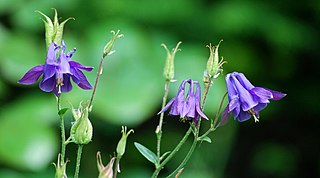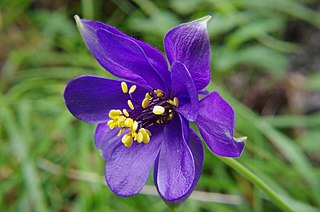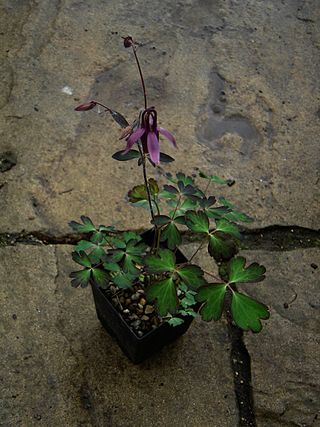
Aquilegia is a genus of about 130 species of perennial plants that are found in meadows, woodlands, and at higher elevations throughout the Northern Hemisphere, known for the spurred petals of their flowers.

Isopyrum is a genus of flowering plants of the family Ranunculaceae native to Eurasia and North America. Isopyrum plants possess white flowers with five sepals and five petals.

Aquilegia hinckleyana, or Hinckley's golden columbine, is a partially recognized species of flowering plant of the genus Aquilegia (columbines) in the family Ranunculaceae endemic to Capote Falls in northwestern Presidio County, Texas. The plant is found within a small region of the county and only grows in moister areas of its generally dry range. Considered a smaller version of Aquilegia chrysantha, A. hinckleyana has a height of around 60 centimetres (24 in) and possesses yellow flowers. It has seen modern cultivation, particularly in Texas. The species is named for L. C. Hinckley, who first collected the species in 1943.

Aquilegia alpina, often called the alpine columbine or breath of God, is a perennial species of flowering plant in the family Ranunculaceae, native to the western and central Alps. Though rare in its Swiss, Austrian, and Italian range, it is commonly found in the French Maritime Alps. A. alpina is appreciated for its light blue to blue-purple flowers.

Semiaquilegia adoxoides is a species of perennial flowering plant in the Ranunculaceae. Native to Japan, Korea, and China, the plant grows to about 40 cm (16 in) tall and blooms with pale pink flowers. Now often considered the sole member of the genus Semiaquilegia, it bears similarities to members of the genus Aquilegia. S. adoxoides is native to China, Korea, and Japan and has an introduced population on Taiwan.

Aquilegia rockii is a perennial flowering plant in the family Ranunculaceae, native to southern China.

Aquilegia parviflora is a species of flowering plant of the Aquilegia (columbine) genus in the family Ranunculaceae native to the Asian regions of Siberia, northern Mongolia, northern China, and Sakhalin.

Aquilegia moorcroftiana is a species of flowering plant in the genus Aquilegia (columbines) in the family Ranunculaceae. It is native to central Asia, with a range spanning Afghanistan, Tajikistan, Pakistan, Kashmir, Nepal, and Tibet. A. moorcroftiana grows at the highest elevation of any species of columbine, with examples frequently found at over 4,000 metres (13,000 ft) of elevation.

Aquilegia confusa is a partially accepted species of flowering plant of the genus Aquilegia (columbines) in the family Ranunculaceae that is endemic to the eastern and southern European Alps in Switzerland and Italy. The entirety of the plant, particularly its seeds, are toxic to humans.

Aquilegia sibirica, the Siberian columbine, is a species of flowering plant in the family Ranunculaceae native to the north-central Asian regions of Siberia, northern Mongolia, Kazakhstan, and Xinjiang. A hardy perennial plant, it prefers temperate environments. The Siberian columbine can be between 1 foot (0.30 m) and 2 feet (0.61 m) tall with flowers that are lilac-blue and white in color.

Aquilegia glandulosa, the Altai columbine or Siberian columbine, is a perennial species of flowering plant in the family Ranunculaceae, native to northern and central Asia.

Aquilegia micrantha, the Mancos columbine or Bluff City columbine, is a perennial species of flowering plant in the family Ranunculaceae. It is native to Utah, Colorado, and Arizona. The species grows to between 30 cm (12 in) and 60 cm (24 in) tall and produces flowers that can be white, cream, blue, or pink.

Aquilegia barykinae is a perennial flowering plant in the family Ranunculaceae, endemic to the Russian Far East. The species was first described in 2014. Its flowers are lilac-blue.

Aquilegia microcentra is a species of flowering plant in the family Ranunculaceae native to Uruzgan Province in central and southeastern Afghanistan. The plant is understood as related to Aquilegia moorcroftiana, which has a range spanning into Afghanistan. A. microcentra has small, white flowers. The species was first described by the Flora Iranica in 1992 from specimens collected by Karl Heinz Rechinger in 1967.

Aquilegia maimanica is a species of flowering plant in the family Ranunculaceae native to the area of the former Meymaneh Province in northwestern Afghanistan. The plant is understood as related to Aquilegia moorcroftiana, which has a range spanning into Afghanistan. A. maimanica has pale-blue and white flowers. The species was first described by the Flora Iranica in 1992 from specimens collected by Karl Heinz Rechinger in 1959.

Aquilegia gracillima is a species of flowering plant in the family Ranunculaceae native to the area near Ghazni in eastern Afghanistan. The plant is understood as related to Aquilegia moorcroftiana, which has a range spanning into Afghanistan.
Aquilegia × emodi is a perennial flowering plant in the family Ranunculaceae, native to the Western Himalayas. It is a natural hybrid of Aquilegia bashahrica and Aquilegia pubiflora.
Aquilegia grubovii is a perennial flowering plant in the family Ranunculaceae, native to northern Mongolia and Tuva in Russia.
Aquilegia hebeica is a perennial flowering plant in the family Ranunculaceae, native to northern China.
Aquilegia kamelinii is a perennial flowering plant in the family Ranunculaceae, native to northeastern China and the Russian Far East.
















